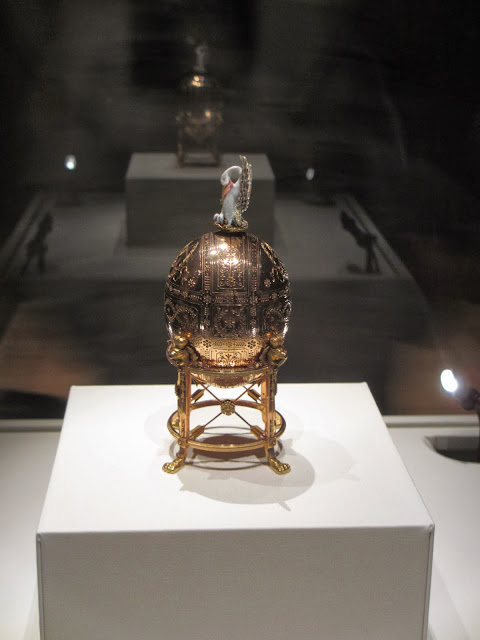I've always been intrigued by Faberge eggs and the tragic story of the last imperial family of Russia, so this exhibit spoke to every nerdy fiber of my being. It started off with what, in my opinion, was the VIP of the exhibit, the Imperial Peter the Great Easter Egg. Made in 1903 for Tsar Nicholas and Tsarina Alexandra, this egg was made to commemorate the reign of Peter the Great, the first great tsar of Russia, and to draw comparisons between Peter and his descendent Nicholas, in an effort to glorify the current tsar.
Before seeing this exhibit, I hadn't realized that Faberge had been known for anything other than its famous Easter eggs, but apparently it enjoyed quite the monopoly on other luxury goods in Russia and even competed with the House of Cartier for the European market for a time. Its picture frames, dishes, and animal figurines, made of precious stones and enamel were quite the prized possessions among the elite in the late 19th and early 20th centuries.
What surprised me the most about the exhibit was the plethora of cane and parasol handles on display. Apparently, during Faberge's heyday, high society men and women had a number of different cane and parasol handles that were made of luxurious materials, and they would swap out the handles based on their outfits for the day. Who knew that parasol and cane handles were once considered a status symbol? Oh how times have changed....
The exhibit flowed through three galleries, and in the last room, the grand finale awaited...three more Faberge Easter eggs, all of which had been made and presented to the Romanovs. While these eggs were made of the most expensive materials, the rest of the imperial household, including every rank of servant, were apparently also presented with eggs on Easter as a token of thanks for their service.
I was blown away by the intricate detail and craftsmanship that went into the eggs, which made me wonder if we still produce anything now that will have such longevity and hold such fascination for future generations. Would anyone take the time or make the effort to create something like these eggs today?
This lapis lazuli egg, made for Alexandra in honor of her only son Alexei, took Faberge craftsmen THREE years to complete. THREE YEARS. Does anyone have that kind of attention span anymore? I mean, that's longer than most master's programs. Sometimes, it's good to be reminded what people could accomplish if only they'd slow down and take pride in their work.
After we finished ogling the eggs and daydreaming about the tragic romanticism of the Romanovs' story, our stomachs were starting to grumble, but we had to make one other pitstop in the museum to see a reconstruction of the first ocean-going yacht from the 1800s. GK was in heaven...she has a thing for sailors.
If you find yourself in Salem and you've had enough of all the witchy kitsch, I'd definitely recommend taking a breather at the Peabody Essex. It really is a beautiful museum and I'm sure that it has many more secrets to tell beyond those of the Romanovs.
































No comments:
Post a Comment